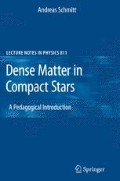Abstract
In this chapter, we will discuss the most basic properties of a compact star, its mass and radius. We have already given typical values for these quantities above. Below we shall connect them with microscopic properties of nuclear and quark matter. This connection is made by the equation of state from which, in particular, an estimate for the maximum mass of the star can be obtained. Let us begin with a simple estimate of mass and radius from general relativity. For the stability of the star we need \(R>R_s\) where R is the radius of the star, and \(R_s=2MG\) the Schwarzschild radius, with the mass of the star M and the gravitational constant \(G=6.672\cdot 10^{-11}\,\mathrm{m}^3\mathrm{kg}^{-1} \mathrm{s}^{-2}=6.707\cdot 10^{-39}\,\mathrm{GeV}^{-2}\). (We shall mostly use units common in nuclear and particle physics, \(\hbar=c=k_B=1\), although astrophysicists often use different units.) For \(R < R_s\) the star becomes unstable with respect to the collapse into a black hole. Let us build a simple star made out of a number of nucleons A with mass \(m\simeq 939\,\mathrm{MeV}\) and a distance \(r_0\simeq 0.5\cdot 10^{-13}\, \mathrm{cm}\) (that’s where the nucleon interaction becomes repulsive). We thus cover a volume \(\sim r_0^3 \,A\) and thus have a radius
Access this chapter
Tax calculation will be finalised at checkout
Purchases are for personal use only
Notes
- 1.
In fact, a compact star has to be electrically neutral to a very high accuracy, as one can see from the following simple estimate. Suppose the star has an overall charge of Z times the elementary charge, Ze, and we consider the Coulomb repulsion of a test particle, say a proton, with mass m and charge e (e having the same sign as the hypothetical overall charge of the star Ze). The Coulomb force, seeking to expel the test particle, has to be smaller than the gravitational force, seeking to keep the test particle within the star. This gives the condition
$$\frac{(Ze)e}{R^2} \le \frac{\mathit{GMm}}{R^2} \, ,$$((2.22))with the mass M and radius R of the star. Even if we are generous with the limit on the right-hand side by assigning the upper limit \(M< Am\) to the mass of the star (if the star contains A nucleons, its total mass will be less than Am due to the gravitational binding energy), we will get a very restrictive limit on the overall charge. Namely, we find
$$\frac{(Ze)e}{R^2} < \frac{\mathit{GAm}^2}{R^2} \qquad \Rightarrow \qquad Z < G\frac{m^2}{e^2}\,A \, .$$((2.23))With the proton mass \(m\sim 10^3\, \mathrm{MeV}\), the elementary charge \(e^2\sim 10^{-1}\) (remember \(\alpha=e^2/(4\pi) \simeq 1/137\)), and the gravitational constant \(G\sim 7\cdot 10^{-39}\,\mathrm{GeV}^{-2}\), we estimate
$$Z< 10^{-37}A \, ,$$((2.24))i.e., the average charge per nucleon has to be extremely small in order to ensure the stability of the star. Since we have found such an extremely small number, it is irrelevant for the argument whether we use a proton or an electron as a test particle. The essence of this argument is the weakness of gravitation compared to the electromagnetic interactions: a tiny electric charge per unit volume, distributed over the star, is sufficient to overcome the stability from gravity.
References
Shapirol, S.L., Teukolsky, S.A.: Black Holes, White Dwarfs and Neutron Stars: The Physics of Compact Objects. Wiley, New York (1983)
Balian, R., Blaizot, J.P.: Stars and statistical physics: a teaching experience. [arXiv:condmat/9909291]
Silbar, R.R., Reddy, S.: Neutron stars for Undergraduates. Am. J. Phys. 72, 892 (2004). [Erratum-Am. J. Phys. 73, 286 (2005)] [arXiv:nucl-th/0309041]
Sagert, I., Hempel, M., Greiner, C., Schaffner-Bielich, J.: Compact stars for undergraduates, Eur. J. Phys. 27, 577 (2006). [arXiv:astro-ph/0506417]
Chodos, A., Jaffe, R.L., Johnson, K., Thorn, C.B., Weisskopf, V.F.: A new extended model of hadrons. Phys. Rev. D. 9, 3471 (1974)
Chodos, A., Jaffe, R.L., Johnson, K., Thorn, C.B.: Baryon structure in the bag theory. Phys. Rev. D. 10, 2599 (1974)
Bodmer, A.R.: Collapsed nuclei. Phys. Rev. D. 4, 1601 (1971)
Witten, E.: Cosmic separation of phases. Phys. Rev. D. 30, 272 (1984)
E. Farhi, E.,Jaffe, R.L.: Strange matter. Phys. Rev. D. 30, 2379 (1984)
Bauswein, A., et al.: Mass ejection by strange star mergers and observational implications. Phys. Rev. Lett. 103, 011101 (2009). [arXiv:0812.4248 [astro-ph]]
Kurkela, A., Romatschke, P., Vuorinen, A.: Cold quark matter. Phys. Rev. D. 81, 105021 (2010) [arXiv:0912.1856 [hep-ph]]
Alford, M., Braby, M., Paris, W.M., Reddy, S.: Hybrid stars that masquerade as neutron stars. Astrophys. J. 629, 969 (2005). [arXiv:nucl-th/0411016]
Alford, M., Blaschke, D., Drago, A., Klahn, T., Pagliara, G., Schaffner-Bielich, J.: Quark matter in compact stars? Nature 445, E7 (2007). [arXiv:astro-ph/0606524]
Author information
Authors and Affiliations
Corresponding author
Rights and permissions
Copyright information
© 2010 Springer-Verlag Berlin Heidelberg
About this chapter
Cite this chapter
Schmitt, A. (2010). Mass and Radius of the Star. In: Dense Matter in Compact Stars. Lecture Notes in Physics, vol 811. Springer, Berlin, Heidelberg. https://doi.org/10.1007/978-3-642-12866-0_2
Download citation
DOI: https://doi.org/10.1007/978-3-642-12866-0_2
Published:
Publisher Name: Springer, Berlin, Heidelberg
Print ISBN: 978-3-642-12865-3
Online ISBN: 978-3-642-12866-0
eBook Packages: Physics and AstronomyPhysics and Astronomy (R0)

